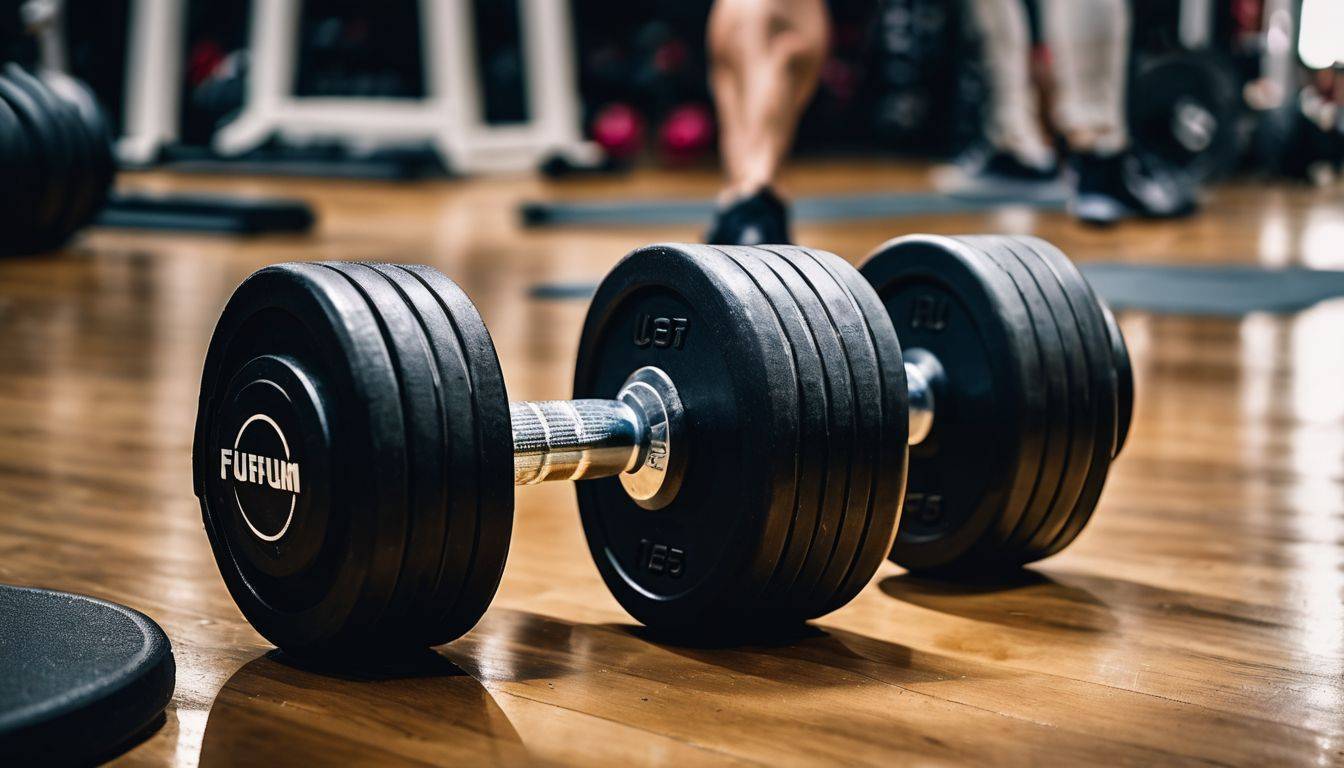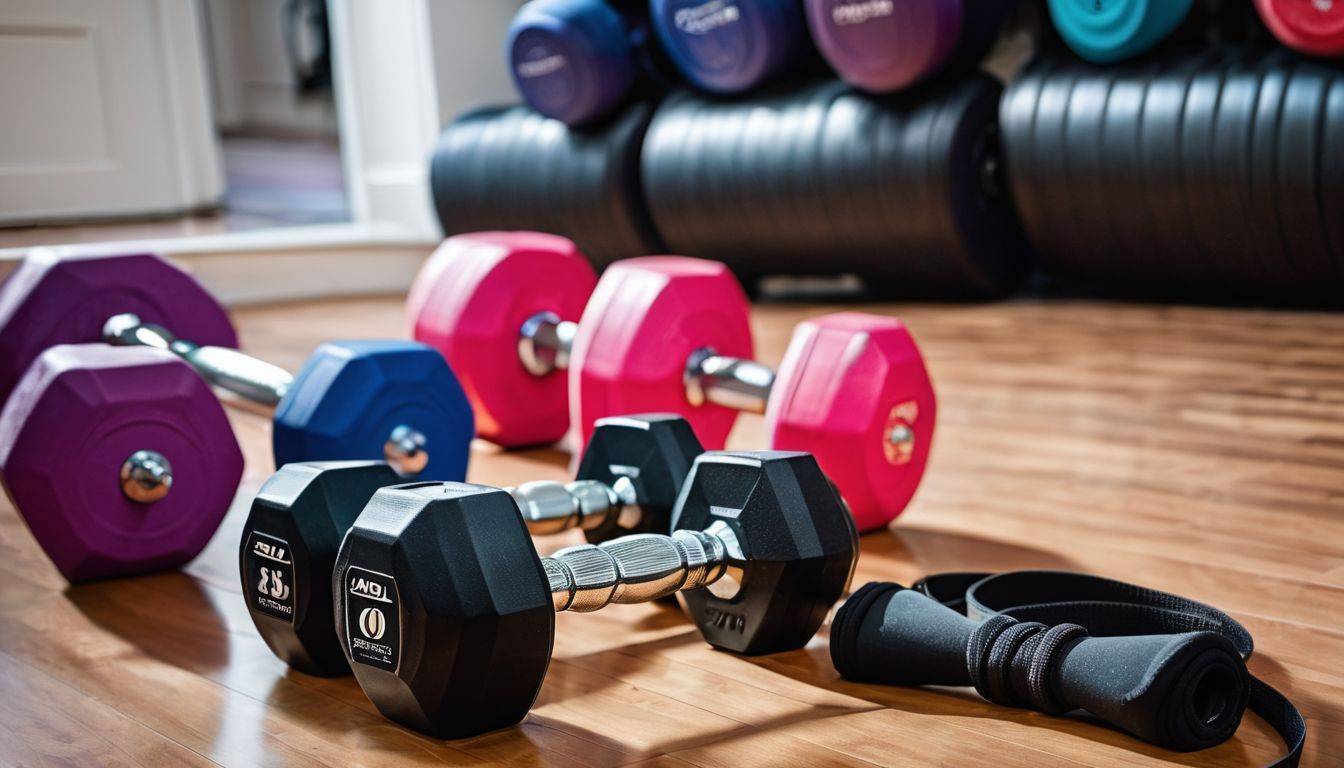Struggling to tone your shoulders without hitting the gym? The deltoid muscle is key for upper body strength and that coveted V-shaped silhouette. Our guide unveils effective home workouts, tailored to power up this crucial trio of shoulder muscles.
Check in—and let’s sculpt those delts!
Key Takeaways
- Deltoid muscles are important for shoulder strength and have three parts: anterior, lateral, and posterior.
- Home workouts like push – ups, Arnold presses, lateral raises, rear delt flies, and burpees can strengthen delts without gym equipment.
- Consistent training is essential; include various exercises for all three deltoid sections at least two to three times a week.
- Proper form is crucial in exercises to avoid injury and build muscle effectively.
- Use household items as weights if necessary and ensure to rest between workout sessions for muscle recovery.
Understanding Deltoid Muscles

To truly master deltoid development, a deep dive into the anatomy of these powerhouse muscles is essential. They cap the shoulders with three distinct heads — each playing a critical role in arm movement and overall shoulder aesthetics.
Anterior Deltoid
The anterior deltoid sits at the front of your shoulder and is key for moves like pressing and lifting. This muscle helps to raise your arm forward. To keep this vital part of the deltoid strong, you need specific exercises that target it directly.
Think about movements that have you pushing weights away from your chest or raising your arms straight in front of you—those will fire up the front delts.
Workout plans often include push-ups, overhead presses, and incline bench presses to work out this muscle group. These exercises make sure your anterior deltoids get a solid workout without needing fancy gym equipment.
Adding these routines into your regular fitness plan can lead to better shoulder strength and muscle growth over time.
Lateral Deltoid
Your lateral deltoid is a key muscle for lifting your arms to the side. Think about reaching out to grab something on a high shelf—that’s your lateral deltoid working hard. To make this muscle stronger, you need specific exercises like lateral raises.
Doing these can help shape and define your shoulder. Picture yourself with more toned shoulders that also move better in every direction.
Start by standing straight, holding weights at your sides. Keep a slight bend in your elbows as you lift the weights out to the side, up to shoulder level, then slowly lower them back down.
You can sit down for seated lateral raises or lean over for bent-over lateral raises too. These moves target those side delts and add power to your upper body, helping you lift heavier items easily and throw a ball farther than before!
Posterior Deltoid
The posterior deltoid is a key muscle in the upper back, often missed during workouts. It’s vital for pulling movements and balances out your shoulder muscles. Strengthening it gives your upper body that broad V-shape look many people want.
To work this muscle well, focus on exercises like rear delt flies and face pulls that target it directly.
Fit the right moves into your routine to hit your posterior deltoids hard. Spend 20 to 35 minutes on these targeted exercises, but remember to take breaks when you need them. Pushing too far may lead to fatigue or soreness, keeping you from future workouts.
So, make sure you rest enough between sets for the best results without overdoing it.
The Importance of Deltoid Workouts

Deltoid workouts are more than just a stepping stone to aesthetic shoulders; they’re the foundation for holistic upper body health and functionality. Whether you’re swinging a tennis racket or reaching for that top shelf, strong deltoids play a crucial role in your everyday movements and overall stability—keeping injuries at bay while fortifying your posture.
Injury Prevention
Strong deltoids help keep your shoulders in good shape. They protect the joint and lower the risk of injury. When you work out your rear deltoid and rotator cuff muscles, you make them stronger.
This can stop common shoulder problems before they start.
Face pulls are great for targeting the back part of your shoulders. Using a cable machine or bands makes these muscles tough and flexible. Include these exercises in your routine to stay safe while lifting weights, playing sports, or doing daily tasks.
Strong shoulders mean you can move freely and without pain.
Enhanced Posture
Keeping your shoulders strong not only prevents injuries but also helps you stand tall and confident. Deltoid workouts encourage better alignment of the spine. This leads to improved posture throughout everyday activities.
Strong deltoids pull your shoulder blades back, reducing the slump that often comes with sitting too much.
Good posture has many benefits; it can make you feel more energetic and alert. It’s also linked to a positive mood and can help you focus better on tasks at hand. Regular deltoid exercises contribute to holding your body correctly whether you’re walking, standing, or sitting down.
With consistent training, these muscles support a healthy stance that enhances both appearance and wellbeing.
Improved Athletic Performance
Strong shoulders are a must for athletes. Working on your deltoids boosts your performance in many sports. Think of swimmers, baseball pitchers, or basketball players; they all need powerful shoulders to play well.
Exercises like the Arnold press and push-ups help build these muscles, making you better at throwing, swimming, and lifting.
Next up is understanding how these workouts fit into your daily routine. Let’s dive into making deltoid exercises a regular part of your fitness plan.
Challenges of Deltoid Workouts

Deltoid workouts can be tough on your shoulders. Sometimes, you might push too hard and not know it until later. Your shoulder joints are delicate and they need you to listen to your body closely.
If you feel pain or get tired, it’s okay to take a break.
Keeping balance in your workout is key for growing strong deltoids. It’s tempting to just do delt exercises all the time, but that’s not good for you. You must work out other muscles too so that everything stays even and healthy.
Remember, taking care of your whole body is part of getting stronger deltoids!
How to Incorporate Deltoid Exercises into Your Fitness Routine

Mixing deltoid exercises into your fitness routine boosts strength and shoulder stability. A solid plan can turn your shoulders into powerful supports for everyday activities.
- Pick a regular workout time that fits your schedule, aiming for 20 to 35 minutes dedicated to deltoids.
- Start every session with a proper warm – up, like arm circles or light jogging, to get the blood flowing to your shoulder muscles.
- Include a variety of deltoid workouts – combine compound movements like push – ups with isolation exercises such as rear delt raises.
- Schedule rest days between intense shoulder workouts to allow muscles time to recover and grow stronger.
- Create balance in your routine by working all three parts of the deltoid: front, side, and rear.
- Use items at home if you don’t have weights, like water bottles or backpacks, for exercises like lateral raises or overhead presses.
- Monitor your progress by increasing resistance or reps gradually; consistent improvement helps build muscle.
Top 8 Deltoid Exercises for Stronger Muscle and Strength
Diving into the world of deltoid sculpting, we uncover eight key exercises that pack a punch in building muscle and strength. These moves are tailored to ignite every fiber of your shoulder muscles, turning any space into your own personal strength-training arena.
Arnold Press
The Arnold Press puts your deltoids to work and honors a bodybuilding legend: Arnold Schwarzenegger. You’ll need two dumbbells for this exercise. Sit or stand with the weights in front of you, palms facing your shoulders.
Lift them overhead by rotating your arms outward as you press up. This move hits all three shoulder muscles—front, middle, and back delts—for a full workout.
Make sure your movements are smooth and controlled; don’t rush it. Begin with lighter weights to master the form before adding more weight for greater challenge. The Arnold Press is not just about raw strength—it’s about technique too, so focus on getting it right to build those muscles effectively.
Burpee
Jump into a burpee and you’re choosing a full-body workout that targets your deltoids, too. Drop down to a squat, kick your feet back, then jump up again; that’s the move people either love or dread.
Burpees build strength and endurance in your delts through powerful movements. With each rep, you push against the earth, recruiting those shoulder muscles hard.
Move swiftly from one burpee to the next for an intense exercise that weaves cardio with muscular work—no equipment needed. This exercise helps prepare you for other deltoid challenges like dumbbell upright rows.
Dumbbell Upright Row
Grab a pair of dumbbells and stand with your feet shoulder-width apart. Keep your back straight and knees slightly bent. Hold the weights in front of you, palms facing your body. This is where you start the dumbbell upright row.
Lift the dumbbells straight up to your chest, leading with your elbows. Your hands should stay close to your body as you raise the weights just under your chin. Squeeze those shoulders at the top then lower the weights slowly back down.
It’s key for building strong deltoid muscles and adding that V-shape to your upper body. With this isolation exercise, you can power up your deltoids workout right at home!
Dumbbell Lateral Raise
Dumbbell lateral raises are a powerful exercise for strengthening your shoulder muscles, especially the middle deltoids. All you need is a pair of dumbbells and some space to stand.
Hold the weights at your sides, keep your back straight, and lift your arms out to the sides until they’re parallel to the floor. Then slowly lower them back down.
Make sure you control the dumbbells both when raising and lowering them. This prevents injury and works the muscle properly. You can try different grips or arm positions to add variety to this exercise for delts.
Keep breathing steadily as you perform each repetition of this deltoid training exercise; it will help maintain good form throughout.
Moving on from traditional lifts, let’s explore how variations like Dumbbell Shoulder Press can further enhance your deltoid workouts at home.
Dumbbell Shoulder Press (Overhead Press/Military Press)
Grab some dumbbells and sit or stand with your back straight. Press the weights upward until your arms fully extend, aiming to feel the burn in your front shoulders and upper chest.
Keep your wrists firm and breathe out as you lift. This shoulder press is a must-do for building strength in key upper body muscles, including those all-important anterior deltoids.
Form counts more than weight; start light to stay safe and get it right before adding more pounds. Studies point out how vital these presses are for a rounded shoulder workout that hits every angle of the delts.
Ready to pull things into balance? Let’s dive into face pulls next!
Face Pull
Face Pulls are a champion move for targeting the rear deltoids. You will need a cable pulley machine or an over-the-door suspension trainer to do them. Stand with your feet shoulder-width apart, pull the handles straight towards your forehead, and then slowly return to start position.
Keep your upper arms parallel to the ground throughout.
Aim for 3 sets of 8 to 12 reps in each workout session. This exercise not only strengthens those important rear delts but also helps support good posture and reduces the risk of shoulder injuries.
Remember to squeeze your shoulder blades together at the peak of the movement for maximum benefit.
Rear Delt Fly
Strengthen your shoulders with the rear delt fly, one of the top exercises for building muscle at home. Grab a resistance band and stand on it with both feet. Keep a slight bend in your elbows as you pull the bands up and out to your sides.
This move hits your posterior delts hard while also working your medial and front delts.
You want strong, balanced shoulders? Make sure to include this exercise in your routine. It’s perfect for targeting each head of the deltoid muscle. You can improve shoulder stability and add definition without stepping into a weight room.
Just focus on form and control—your delts will thank you later!
T Push-Up
Get ready to give your delts a powerful workout with the T Push-Up. This exercise hits more than just your shoulders; it also engages your chest and core. You don’t need any special gear – all you need is your body and enough space to get into push-up position.
First, start in a standard push-up pose with hands shoulder-width apart. As you push back up from the floor, lift one arm off the ground and rotate into a side plank, forming a ‘T’ shape with your body.
Keep switching arms for each rep, aiming for 3 sets of 8-12 reps on each side. The T Push-Up will not only build muscle but boost your overall upper-body strength too. It’s an ideal move for making at-home workouts count towards sculpting those delts! After mastering this move, consider adding dumbbell deltoid workouts to further challenge yourself and keep progressing.
Dumbbell Deltoid Workouts
Dumbbell deltoid workouts target the shoulder muscles. They boost strength and muscle size.
- Start with the Arnold press. Sit or stand with two dumbbells at shoulder height. Rotate your wrists as you press the weights above your head. Then, bring them back to the start.
- Try a dumbbell upright row next. Stand straight and lift two dumbbells close to your body. Lead with your elbows and stop when they reach shoulder height.
- Move on to dumbbell lateral raises. Hold a dumbbell in each hand at your sides. Keep a slight bend in your elbows as you raise your arms out to the side.
- The dumbbell shoulder press works well too. Hold the weights at shoulder level and push them up over your head until your arms are straight.
- Do face pulls. Attach a resistance band to something sturdy at upper – chest level. Pull towards your face with elbows high, then return slowly.
- Rear delt flys focus on the back of the shoulders. Bend forward slightly, holding dumbbells with palms facing each other, then lift out to the side like bird wings.
- Finish with T push-ups for a challenge. Perform a push-up, then rotate into a side plank lifting one arm and weight toward the ceiling, forming a ‘T’ shape with your body.
Guide to At-Home Deltoid Workouts
Training deltoids at home can be simple and effective. You don’t need a gym membership or fancy equipment to get started.
- Find enough space where you can move your arms freely. Clear an area in your living room or bedroom.
- Use household items as weights if you don’t have dumbbells. Water bottles or canned goods work well.
- Start with a warm – up to prepare your muscles. Do arm circles, shoulder rolls, and jumping jacks for five minutes.
- Try push – ups to engage your anterior deltoids. Keep your elbows close to your body to focus on the shoulders.
- Perform pike push – ups for a challenging variation. Elevate your hips and lower your head towards the ground targeting the upper deltoids.
- Include lateral raises to hit the middle deltoids. Stand straight, lift arms to the side with water bottles in hand, then lower them slowly.
- Work on posterior deltoids with reverse flyes. Bend forward slightly and lift arms like wings using soup cans for resistance.
- Incorporate T push-ups into your routine for compound movement. Do a push-up, rotate into a side plank, and raise one arm towards the ceiling.
The Role of Deltoids in Upper Body Workouts
Deltoids are key players in upper body strength. They help you do push-ups, pull-ups, and other movements where your arms lift away from or move in front of your body. These muscles sit on your shoulders and come into action during exercises like the overhead press or lateral raises.
Strong deltoids mean you can handle heavier weights and protect joints like the rotator cuff from injury.
The deltoids also support good posture by holding up the scapula (shoulder blade) and collarbone. This helps keep the back straight and reduces neck strain. Upper arm bone health benefits from well-trained deltoids too, as they aid in lifting and carrying objects day to day.
Next up, let’s dive into frequently asked questions about deltoid workouts!
FAQs on Deltoid Workouts
How can I increase my deltoid size?
To boost your deltoid size, focus on exercises that target all three sections of the muscle: the anterior, lateral, and posterior deltoids. Use moves like Arnold presses and dumbbell shoulder presses to work the front delts.
Dumbbell lateral raises are great for hitting the side delt muscles. Don’t forget rear delt flies to strengthen the back part.
Heavy lifting is key for muscle growth, but proper form matters too. Make sure you increase weights gradually to challenge your delts without hurting yourself. Mix in compound exercises like burpees and T push-ups to engage multiple muscle groups at once.
This approach helps build overall strength and muscular balance which supports larger deltoids.
Include variety in your workouts with both isolation and compound movements. Regularly change up your exercise routine to avoid plateaus and keep your muscles guessing. Consistency is crucial – train your delts two or three times a week for best results.
Good nutrition also plays a vital role in growing bigger muscles. Eat plenty of protein along with healthy fats and carbs for energy and recovery after tough workouts.
Do these things consistently while maintaining good form, patience, dedication – you’ll see those deltoid muscles grow stronger over time!
How do you target deltoids?
Targeting deltoids means focusing on exercises that work the shoulder muscles. You can hit these muscles from different angles for growth and strength. Start with specific moves like the dumbbell lateral raise to engage the side delts.
Then, tackle your front delts with an Arnold press or a regular shoulder press. Don’t forget your rear delts – include face pulls and rear delt flies in your routine.
Keep each set challenging but doable, and rest for 30 seconds to a minute between sets. This will help you prevent injury and build stronger shoulders. Always warm up before a workout first, as cold muscles are prone to injury.
Remember, it’s okay to feel tired after deltoid workouts — just be sure to give yourself time to recover before hitting those muscles again.
How do you build your deltoid muscle?
Once you’ve zoned in on your deltoids, it’s time to shift focus to building them up. A solid plan includes exercises that hit all three parts of the muscle: anterior, lateral, and posterior deltoids.
For growth, concentrate on moves like dumbbell shoulder presses for overall strength and Arnold presses to get those front delts working hard. Mix in some side lateral raises; they’re perfect for hitting the middle fibers.
Don’t forget about your rear delts—reverse flyes will target these effectively.
Consistency is key in any workout routine, especially when strengthening your shoulders. Aim for two to three times a week with enough weight or resistance so the last few reps feel challenging but still doable.
Keep proper form and control at all times — this ensures every rep counts and helps prevent injury. Remember to fuel up with good nutrition and allow plenty of rest between workouts – muscles need downtime to rebuild stronger than before!
Are deltoids easy to build?
Building deltoids can be challenging. These muscles are small and have three distinct parts that need focused exercises. The front, side, and back of the shoulders each require different moves to grow stronger.
It takes a mix of proper technique and regular training. You also have to gradually increase weight or reps over time.
Everyone’s body responds differently to workouts for deltoids. Some people might see results quickly while others take longer. Stick with your deltoid exercises regularly to improve strength in this area.
Make sure you give these muscles time to rest between workouts too! This helps them recover and build up even more effectively after each session.
How can I build my deltoids without weights?
You can still grow strong deltoids without lifting weights. Try push-ups to work your entire shoulder. They target your anterior and lateral deltoid muscles. For your posterior delts, do rear delt rows using just body resistance or try a door frame row for strength.
Make these moves part of your home workout routine.
Incorporate arm circles into your daily exercise for deltoids too. Stand tall and extend your arms, then make small, quick circles forward and backward. This simple action fires up all three parts of the deltoid muscle – anterior, lateral, and posterior heads.
Keep changing directions to hit every angle of those delts!
Conclusion
Building strong deltoids at home is both doable and rewarding. With the right exercises, you can power up your shoulder muscles and boost overall strength. Remember, balance is key—mix different moves to hit all parts of your delts.
Stay consistent with your workouts, listen to your body’s needs, and rest when necessary. Unleash the potential of deltoid training; embrace the challenge for a stronger you!
